My son, who is 14, is a music fanatic with wide-ranging tastes. He recently took a deep dive into the discography of The Clash, and listening to “London Calling” with him was like hearing it for the first time. True classics endure, never losing their capacity to surprise you—which is also how I felt about today’s Valpolicella Ripasso from the historic Tenuta Novare.
Ripasso is a formative style of wine for aspiring Italian wine geeks, a signature product of the Valpolicella hills outside Verona, but in our never-ending quest for the new, many of us have left Ripasso (and its big brother, Amarone) behind. So, it was a genuine treat to encounter this perfectly realized 2016: It captures the spirit and letter of Ripasso perfectly and delivers loads of pleasure in the process. It’s the first Ripasso I’ve had in I don’t know how long, and its spot-on performance felt new and exciting, like hearing “London Calling” again after a long hiatus. For all the Italian wine fans out there, this one is not to be missed: It’s going to bring you back, and it’s a brilliant value besides!
The name Tenuta Novare will be familiar to many: Headquartered in the heart of the Valpolicella production zone, it is owned by the iconic Bertani wine estate, one of the original producers of Amarone wines. The Bertanis acquired Tenuta Novare in 1957, but the property’s wine history goes back much further: Grape-growing on the property was first documented in the year 1028 and its wines had a significant international presence long before the Bertanis came along. Today, the estate farms more than 100 hectares of vineyards dedicated to Valpolicella wine “in all its forms.”
One such form is, of course, ripasso: There may be other vintners around the world who make wines in this style, but for the most part, it’s a practice that belongs to Italy, and, more specifically, to the hills north of Verona. Meaning “re-passed” in Italian, ripasso is when a finished wine is subjected to a second maceration/fermentation on the skins and pulp of dried grapes. It grew out of another tradition unique to Valpolicella—the production of Amarone—and it’s the wine version of “using the whole animal.” Amarone is made from grapes that are dried for several months after harvest, and the skins and pulp of those ultra-concentrated grapes have a lot to give, even after the Amarone is finished fermenting; after they’ve “racked off” their Amarone, many producers take a Valpolicella wine they made in the fall and put it in the tank with all the solids leftover from the Amarone fermentation. The result is a velvety, more concentrated Valpolicella that borrows some of the chocolate-cherry richness of Amarone while holding onto its freshness and nerve.
Because so much of ripasso is about technique, people tend to forget about the Valpolicella terroir: Located outside the village of Negrar, Tenuta Novare is right in the heart of Valpolicella Classico, a band of north-south valleys that run towards Verona from the Monte Lessini, which form part of a natural border with the Trentino region. At the western edge of the Valpolicella Classico are the Adige River and Lake Garda. Vineyards here spread over the hills of the Fumane, Marano, and Negrar Valleys with soils that include a significant amount of volcanic material alongside clay and limestone.
The grapes for today’s 2016 (80% Corvina and 20% Rondinella) were hand-harvested toward the end of September and fermented in steel tanks. The finished wine rested in tank until March of the following year, when Novare’s Amarone wine finished fermenting, at which point the reserved Valpolicella wine was added to the tank containing the solids leftover from the Amarone fermentation. After this brief maceration and re-fermentation, the newly minted Ripasso spent six months aging in oak before bottling.
The result is a classic expression of this style, borrowing some of Amarone’s chocolate and licorice notes without taking on its weight or elevated alcohol. In the glass, it’s a deep ruby red with hints of black and magenta, with aromas of black cherry, black currant, plum, violets, ground coffee, nutmeg, cocoa, and dark soil. It is medium-plus in body, with the plush, velvety texture that characterizes the ripasso style. Decant it 15-30 minutes before serving it in Bordeaux stems at 60 degrees and pair it with something homey and hearty—like the attached meatloaf recipe. Keep it simple and classic: that always works!









